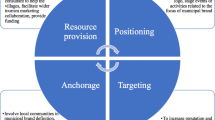Abstract
Numerous methods of analyzing a place’s image have been proposed due to the increasing importance of place branding. However, studies have failed to incorporate a place’s identity, an important counterpart of a place’s image. To overcome the limitation, this study introduces a new method that analyzes a place’s image in comparison with its identity using the Brand Concept Map and network analysis. A pilot study was conducted in 2014 to illustrate the method using Seoul, the capital of South Korea. The study found that the residents share similar images of the city, regardless of the district they live (i.e., Gangbuk, Gangnam 3 Gu, or Gangnam Others). However, their images greatly differ from the city’s identity.






Similar content being viewed by others
References
Anderson, J.: The Architecture of Cognition. Harvard University Press, Cambridge (1983)
Anholt, S.: Anholt City Brand Index—How the World Views Its Cities, 2nd edn. Global Market Insight, Bellevue (2006)
Ashworth, G., Kavaratzis, M.: Beyond the Logo: Brand Management for Cities. Brand Manag. 16(8), 520–531 (2009)
Barsalou, L.W.: Perceptual symbol systems. Behav. Brain Sci. 22, 577–660 (1999)
Baudrillard, J.: Metaphors of consciousness and attention in the brain. Trends Neurosci. 21(2), 58–62 (1994)
Borgatti, S.P.: NetDraw Network Visualization. Analytic Techonologies, Harvard (2002)
Borgatti, S.P., Everett, M.G., Freeman, L.C.: UCINET 6 for Windows: Software for Social Network Analysis. Analytic Technologies, Harvard (2002)
Cai, I.A.: Cooperative Branding for Rural Destinations. Annals of Tourism Research 29(3), 720–742 (2002)
Cornelissen, J.P., Thorpe, R.: The organization of external communication disciplines in UK companies: a conceptual and empirical analysis of dimensions and determinants. J. Bus. Commun. 38(4), 413–438 (2001)
Giraldi, A., Cesareo, L.: Destination image differences between first-time and return visitors: an exploratory study on the city of Rome. Tour. Hosp. Res. 14(4), 197–205 (2014)
Glaser, M.: The business psyche: exploring relationships between local quality of life and city image. Publ. Adm. Q. 15(3), 287–303 (1991)
Greicius, M.D., Krasnow, B., Reiss, A.L., Menon, V.: Functional connectivity in the resting brain: a network analysis of the default mode hypothesis. Proc. Natl. Acad. Sci. USA 100(1), 253–258 (2002)
Hankinson, G.: Repertory grid analysis: an application to the measurement of destination images. Int. J. Nonprofit Volunt. Sect. Mark 9(2), 145–153 (2004)
Haythornthwaite, C.: Social network analysis: an approach and technique for the study of information exchange. Lib. Inf. Sci. Res. 18(4), 323–342 (1996)
Henderson, G.R., Iacobucci, D., Calder, B.J.: Using network analysis to understand brands. Adv. Consum. Res. 29, 397–405 (2002)
Hospers, G.: Lynch, Urry and city marketing: Taking advantage of the city as a built and graphic image. Place Branding Public Dipl. 5(3), 226–233 (2009)
John, D.R., Loken, B., Kim, K., Monga, A.B.: Brand concept maps: a methodology for identifying brand association networks. J. Mark. Res. 43(4), 549–563 (2006)
Kavaratzis, M.: Place branding: a review of trends and conceptual models. Mark. Rev. 5, 329–342 (2005)
Kavaratzis, M., Hatch, M.J.: The dynamics of place brands: an identity-based approach to place branding theory. Mark. Theory 13(1), 69–86 (2013)
Keller, K.L.: Conceptualizing, measuring, and managing customer-based brand equity. J. Mark. 57(1), 1–22 (1993)
Koll, O., von Wallpach, S., Kreuzer, M.: Multi-method research on consumer-brand associations: comparing free associations, storytelling and collages. Psychol. Mark. 27(6), 584–602 (2010)
Konecnik, M., Go, F.: Tourism destination brand identity: The case of Slovenia. Brand Manag. 15(3), 177–189 (2008)
Kotler, P., Andreasen, A.R.: Strategic Marketing for Non-profit Organization. Prentice Hall, New Jersey (1991)
Kotler, P., Haider, D.H., Rein, I.: Marketing Places: Attracting Investment, Industry and Tourism to Cities, States, and Nations. Free Press, New York (1993)
Krackhardt, D.: QAP partialling as a test of spuriousness. Soc. Netw. 9, 171–186 (1987)
Landry, C.: The Art of City Making. Earthscan, London (2006)
Lee, K.H., Seo, S.J.: A study on the regional disparity between the major 3 Gangnam districts and the major 3 Gangbuk districts in Seoul. Kor. Publ. Manag. Rev. 12(4), 357–381 (2009)
Lynch, K.: The Image of the City. MIT Press, Cambridge (1960)
MacInnis, D.J., Jaworski, B.J.: Information processing from advertisements: toward an integrative framework. J. Mark. 53(4), 1–23 (1989)
Mahutga, M.C.: The persistence of structural inequality? A network analysis of international trade, 1965–2000. Soc. Forces 84(4), 1863–1889 (2006)
Merrilees, B., Miller, D., Herington, C.: City branding: a facilitating framework for stressed satellite cities. J. Bus. Res. 66(1), 37–44 (2013)
Pike, S.: Destination brand positions of a competitive set of near-home destinations. Tour. Manag. 60(6), 857–866 (2009)
Pocock, D., Hudson, R.: Images of the Urban Environment. Macmillan Press, London (1978)
Rainisto, S.K.: Success factors of place marketing: a study of place marketing practices in Northern Europe and the United States. Doctoral dissertation, Helsinki University of Technology, Institute of Strategy and International Business (2003)
Schnittka, O., Sattler, H., Zenker, S.: Advanced brand concept maps: a new approach for evaluating the favorability of brand association networks. Int. J. Res. Mark. 29(3), 265–274 (2012)
Trueman, M., Klemm, M., Giroud, A.: Can a city communicate? Bradford as a corporate brand. Corp. Commun. 9, 317–330 (2004)
Urry, J.: The Tourist Gaze: Leisure and Travel in Contemporary Societies. Sage, London (1990)
Upadhyaya, M.: Influence of Destination Image and Destination Personality: An Empirical Analysis. J. Market. Commun. 7(3), 40–47 (2012)
Zenker, S.: Braun, E. Branding a city: A conceptual approach for place branding and place brand measurement. Paper Presented at the 39th European Marketing Academy Conference, Copenhagen, Denmark (2010)
Zenker, S., Eggers, F., Farsky, M.: Putting a price tag on cities: insights into the competitive environment of places. Cities 30, 133–139 (2013)
Author information
Authors and Affiliations
Corresponding author
Rights and permissions
About this article
Cite this article
Ci, C., Choi, S. How to manage a city’s image using the brand concept map and network analysis: a case of Seoul. Qual Quant 51, 2441–2456 (2017). https://doi.org/10.1007/s11135-016-0402-6
Published:
Issue Date:
DOI: https://doi.org/10.1007/s11135-016-0402-6




